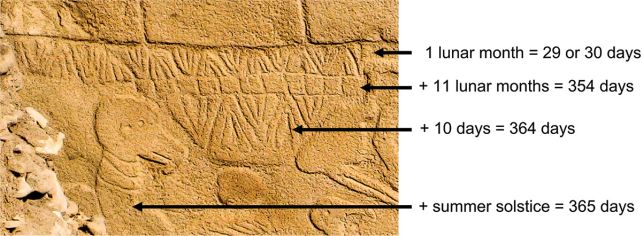ARTICLE AD
The ancient monument of Göbekli Tepe in Türkiye is truly one of the most magnificent ancient marvels on our planet.
The temple complex that thrived as a cultural epicenter more than 10,000 years ago is the oldest monument of its kind, handing down mysteries from a people long, long past.
And now, a carving on a wall in the complex could be the earliest evidence of a calendar, used to track the passage of time and the turning of the seasons.
We don't know exactly how the Neolithic people of Türkiye used Göbekli Tepe, but recent findings suggest that it was occupied at least some of the time as an observatory for monitoring the changes in the night sky. Of particular note is a carved pillar known as the Vulture Stone, on which is etched the figure of a bird, amid stylized patterns.
Previous research led by chemical engineer Martin Sweatmand showed how figures on the Vulture Stone could represent constellations, and how other carvings on the stone may record the fall and impact of a comet some 13,000 years ago, before the monument was built.
That impact would coincide with an event that triggered a mini ice age known as the Younger Dryas, which had consequences around the world. It also seems to have occurred at a time when populations were increasingly turning to agriculture in what is known as the Neolithic Revolution.
 Counts that reveal the possible representation of a year. (M. Sweatman, Time and Mind, 2024)
Counts that reveal the possible representation of a year. (M. Sweatman, Time and Mind, 2024)Sweatman has now taken his analysis a step further, showing that the V-shaped marks carved onto the pillars at Göbekli Tepe could represent days, while carvings on other pillars may depict other cosmic events.
In an exhaustive analysis that runs for more than 50 pages, Sweatman lays out his reasoning. He counted and studied the V-shaped marks, and found that if each mark represents a single day, then one of the pillars shows a year, with 365 days, consisting of 12 lunar months and 11 extra days to make up the solar year.
The bird of prey represented on the Vulture Stone wears a V symbol around its neck. According to Sweatman's analysis, a bird of prey represents the constellation associated with the summer solstice, suggesting that the V symbol worn by the bird represents the solstice itself.
Other figures on other pillars have similar V symbols at their necks, as well as statues and figures found at other locations. These symbols, Sweatman says, may also have something to do with the passage, control, or demarcation of time.
The earlier analysis led by Sweatman also found a link between the animals on the pillars and Earth's precession; that is the changing orientation of Earth's rotational axis. And two of the pillars also seem to depict the annual Taurid meteor shower, which is thought to be the likely source of the Younger Dryas comet.
Sweatman's previous findings have been disputed by archaeologists excavating on site at Göbekli Tepe, and it's not unlikely that his new analysis will also have its detractors. But it all fits together very neatly, and, as a growing body of research is increasingly revealing, our ancestors were more than capable of observing, analyzing, and recording the changes in their world.
Further study and discussion will no doubt ensue, but that will only be a win for science, really.
We'll leave the final word to Sweatman himself – for now.
"It appears the inhabitants of Göbekli Tepe were keen observers of the sky, which is to be expected given their world had been devastated by a comet strike," he says.
"This event might have triggered civilization by initiating a new religion and by motivating developments in agriculture to cope with the cold climate. Possibly, their attempts to record what they saw are the first steps towards the development of writing millennia later."
The findings have been published in Time and Mind.

 3 months ago
27
3 months ago
27 

